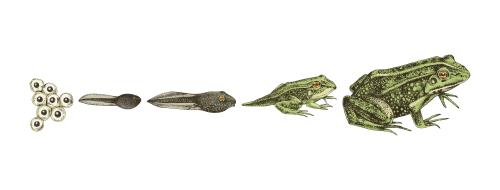Difference Between Reptiles and Amphibians
Reptiles and amphibians as a group are made up of over 17,000 described species worldwide, with many species yet to be described. They have a few things in common but differ greatly in how they live. To truly understand what makes each group of amazing animals unique, let’s start out by talking about what they have in common and what makes these creatures similar.
Similarities:
You can find these two types of animals all over the world and many times in the exact same places. Reptiles and amphibians are both cold-blooded (ectothermic) animals. This means that they don’t create and maintain their own internal body temperature like we do. The temperature of these creatures will rise and lower with their surroundings. Reptiles help create that fluctuation of their temperature by utilizing external behaviors such as basking. This makes reptiles a little different and this behavior categorizes them more precisely as poikilothermic. Amphibians rarely bask under sunlight because it will dry out their skin. Both are also vertebrate animals, meaning they have a spine unlike insects or bacteria. With a few exceptions, all of these creatures also have lungs, though many can breathe through their skin or other gas exchange methods. Much like birds, reptiles and amphibians both have a cloacal chamber. The cloaca is the same opening for their urinary, intestinal, and reproductive tracts to exit their body. Lastly, they both have a three-chambered heart, other than the exception of crocodilians which have four. They are both diverse groups of animals within themselves, but let’s look at what makes each group different.
Differences:
The biggest difference between reptiles and amphibians is how they enter the world. Reptiles are born live or hatched from leathery or hard-shelled eggs. Even when taking their first breath, they are already miniature versions of their mature adult parents. Baby reptiles are ready to hide, bask, and chase down prey all by themselves from the moment they enter the world. Amphibians are hatched from gelatinous eggs laid in or around water, although live birth does occur in very few species. Their physical form has three stages during development, though newts have four. The first form is the egg. Amphibians generally lay their eggs in large masses in ponds or stagnant bodies of water. Some rainforest species lay their eggs in the water of bromeliads or a puddle on a leaf throughout the year, while other species all breed at the same time of the year in mass. In the eggs, small tadpoles develop and break free. This is their second stage of life, larvae. Their larval state is where they begin to develop and gain size. Living fully aquatically and breathing though gills, these larval amphibians also have smooth slimy skin to protect them. Once they grow legs, they begin to absorb their tail and gills until they have fully developed into their final form, whether that be a frog, toad, or salamander. Newts have one more life stage when they become fully mature and return to the water to breed for the remainder of their lives. From there they grow into mature animals and the cycle begins again.

Their Skin:
One easily noticeable difference between reptiles and amphibians is their skin. While both classes of animals shed their skin, the biology and structure of their skin is quite different. Reptiles generally have thin and often delicate skin covered in protective durable scales. These scales are made of keratin just like our hair and fingernails. Scales protect the reptile from predators and the rough terrains they can live in. Scales can also affect how they absorb the rays of the sun and help protect desert dwelling species. Amphibians on the other hand, have either smooth slimy skin or rough dry skin. Larval amphibians, frogs, salamanders, and caecilians all have slimy smooth skin. Adult toads and newt efts have dry rough skin. Amphibians can breathe through their skin passively, along with or instead of active breathing with their lungs. This is one reason the mucus or wax they secrete and their slimy skin are so important. The wax or slime helps keep the skin moist and able to keep transferring oxygen to their blood cells.
Not Negative, Just Toxic
Both reptiles and amphibians have the ability to carry toxic compounds in their bodies, but the delivery method and use of the toxins differs greatly. In reptiles we think of venomous snakes such as the Western Diamondback Rattlesnake. Most of the reptiles that have venom are snakes, but there are also a few lizards and some hypothesis on others. Venom is a toxic liquid comprised proteins and other compounds that is developed in glands in the head of a snake or lizard. Cobras, vipers, and colubrids are the groups of snakes that are venomous, but Komodo dragons, gila monsters and beaded lizards are also venomous. There is research that is slowly showing venomous compounds in the saliva of other species of lizards, but what that shows evolutionarily or medically is unclear so far. Reptiles use venom in order to kill or subdue prey items, although spitting cobras can also project the venom into a predator’s eyes to avoid being eaten. There are also a few snakes that are poisonous. One is a snake that eats poisonous newts and absorbs that poison into its skin to protect itself, the other eats toad and processes poison from the toads into a new poison it holds in glands in its neck. While poison in the skin isn’t common in reptiles, it’s almost exclusively what amphibians can carry. From the Poison Arrow Frogs of the Amazon rainforest to the American Toads found in our backyards, there are many species of amphibians that carry toxins in their skin. Amphibians that are highly toxic will usually also have bright colors. This tells predators that they are poisonous and to avoid eating them. In amphibians, the poison in their skin is a defense mechanism as compared to reptiles where it is used mainly to subdue prey.
Similar, but Different and Disappearing
Both are ectothermic. Both are vertebrates. They are even biologically similar in many ways, but in the end, they are also so different. While reptiles and amphibians share the same habitats, they do not always fill the same niche. Both types of animal are highly evolved creatures that have adapted to their habitat and the microhabitats they live in. Unfortunately, those habitats are being lost at incredible rates. If we want to continue to find these amazing creatures in their native habitats, we need to help to conserve those areas, reduce our impact on the environment around us, and continue to share our love for these cool creatures with others.
